Pedro Tyler
The measure of all things
The visual artist Pedro Tyler has repeatedly concerned himself with systems of measurement in his work. By de-contextualizing “measuring rulers” − made from such materials as wood and metal − he generates a variety of compositions through which he achieves the construction of forms and mechanisms that are completely unexpected in terms of these objects. Leaving aside their intrinsic purpose, his works appear to be devoted specifically to measuring the degree of observation and perplexity they elicit in the viewer.
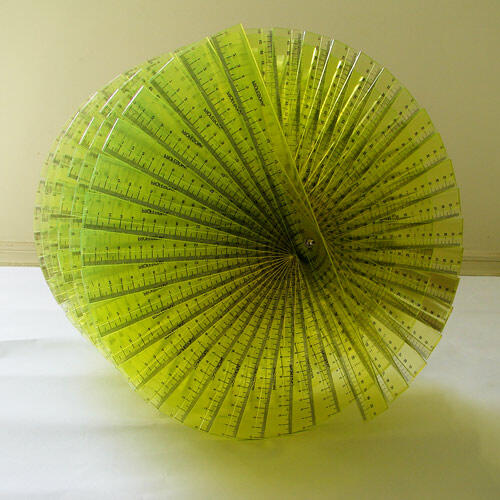
I would like to consider in this commentary, a piece of information that is not without significance: the universal system of measurement was created only recently. Before the 19th century, the prevailing unit of length was the “royal cubit”, understood as the distance comprised between the elbow and the tip of the outstretched fingers. Many historical episodes and political disputes revolved around the issue of measurement; for some of the actors involved, the variability of the information was convenient, while for others − representing imperial ventures − it was insufficient and impossible to implement at the moment of exploring new worlds. In order to establish the system of colonial seizure, the instruments required to achieve that goal had to be put into practical effect. Technologies currently considered rudimentary, yet effective, invested with legitimacy the interests of a process of globalization developed at a modern-day pace, committing a wide cultural heterogeneity to become homogeneous under a “ruler”.
These “rulers” have currently adopted the corporeal form in instruments of everyday use, which we employ to weigh and measure the world around us, constructing a tangible and appropriable “truth”. The visual artist Pedro Tyler has consistently worked with these elements, creating curious compositions. In 2008 he exhibited the piece Esfera del saber (Sphere of Knowledge), consisting of a ruler twisted over itself, emanating a centrifugal force, and reminiscent of the global measuring devices of ancient times. Like this work, those developed over the course of a decade have featured inventive objects having rulers as their main material. As a transformation of rationality to its subjective state, the artist presented the project titled Desvelo (Sleeplessness) at Sala de Arte CCU. There he installed eight life-size beds made of wooden tape measures; over each of them he placed a dichroic zigzag design, producing a swinging effect. The beds gave the impression that they were being used; they were curved as if they bore the imprint of an absent body. In the adjoining space, the artist mounted a series of light boxes featuring photographs of the same beds set up in different landscapes (mountain, desert, seaside, and city).
Contrary to what he did in his earlier work, Tyler now experiments with the same element, but creating a mise-en-scene that holds a dialogue with sleep. This latter question, which is related in an unclear manner with reason, permeates the work with a turn. The bed, as object of everyday use, is necessarily based on the body as measure of all things, but on a body extrapolated from its rational dimension: a body which is suspended, perplexed and out of focus, and which, when entering the world of dreams, twists the ruler, flying over “out of measure” spatial territories, like the landscapes. By going beyond its own system of measurement, this work becomes a fable that points to the dreamlike density this system possesses, just like the genealogy of its history.
In one of Luis Camnitzer’s writings entitled “La parábola de Mario” (“Mario’s Parable”), we are faced with an individual who measured everything based on his own body, resorting to the “royal cubit”, which represented the ancient system of measurement, but there was a particular trait: the tip of his finger did not exist; the story went that it had been blown off by a rifle shot. For Camnitzer, his friend Mario played a fundamental role for his understanding that the systems of measurement are cultural impositions; that the meter is a universal agreement initially created on the basis of a king’s arm, and that everything is pure abstraction and error. We are only left with the option of re-inventing and constructing our own measurements for everything, as a resistance measure against a globalization that makes everything appear to be the same. In Tyler’s case, he does so using the instruments of “truth” to re-elaborate them from the perspective of art; and in Mario´s, as “somebody who rejects the imagination proposed by globalization and persists in his own,” according to Camnitzer.
Profile
Artist Pedro Tyler was born in Montevideo in 1975, he spent his childhood in Punta del Este, and in 1997 he began his studies at Finis Terrae University in Santiago de Chile, where he majored in Sculpture. He has had solo and group shows in Argentina, Canada, Colombia, USA, England, Mexico, Bolivia, Chile and Uruguay, and he received distinctions in the three latter. In 2008, he won the Plataforma Award at the 53rd National Visual Arts Award in Uruguay. His works are represented in the collections of the Juan Manuel Blanes Museum, the Contemporary Art Space of the Uruguayan Ministry of Education and Culture, and the Museum of Contemporary Art of Santa Cruz de la Sierra, Bolivia, as well as in private collections in Latin America, the United States and Europe. He lives and works in Santiago de Chile.
-
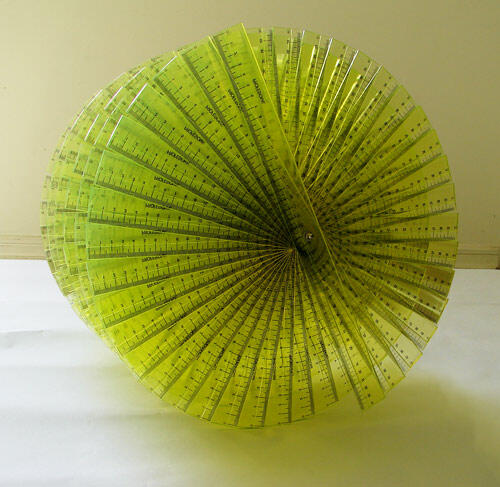 Una cosa que piensa, 2010. Acrylic rulers and screw, 15,7 x 11,8 in. Reglas de acrílico y tornillo, 40 x 30 x 30 cm. Isabel Aninat Gallery, Santiago de Chile.
Una cosa que piensa, 2010. Acrylic rulers and screw, 15,7 x 11,8 in. Reglas de acrílico y tornillo, 40 x 30 x 30 cm. Isabel Aninat Gallery, Santiago de Chile.
Courtesy/cortesía: Pedro Tyler -
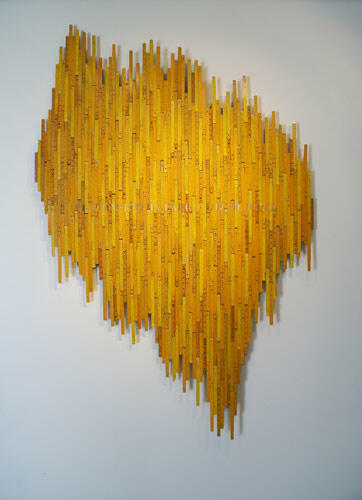 Principio y fin, 2010. Wooden rulers, 50,7 x 78 x 23 in. Reglas de madera, 130 x 200 x 6 cm.
Principio y fin, 2010. Wooden rulers, 50,7 x 78 x 23 in. Reglas de madera, 130 x 200 x 6 cm.
Courtesy/cortesía: Pedro Tyler -
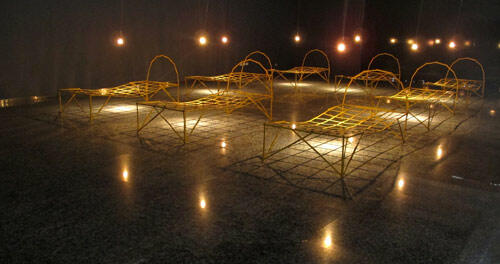 Dulce Compañía, 2011. Wooden rulers, electrical lighting device, 26,2 x 16,4x 9,8 in. Reglas de madera, dispositivo eléctrico de iluminación 800 x 500 x 300 cm.
Dulce Compañía, 2011. Wooden rulers, electrical lighting device, 26,2 x 16,4x 9,8 in. Reglas de madera, dispositivo eléctrico de iluminación 800 x 500 x 300 cm.
Courtesy/cortesía: Pedro Tyler -
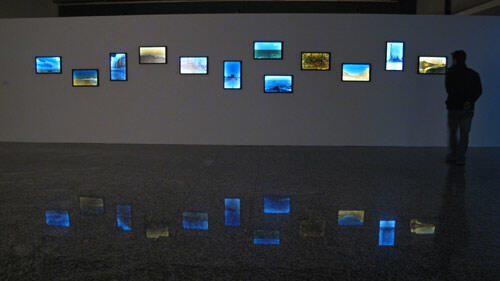 Noches Difíciles, 2011. Photograph on backlight, dimesions variable. Fotografía retroiluminada, dimensiones variables.
Noches Difíciles, 2011. Photograph on backlight, dimesions variable. Fotografía retroiluminada, dimensiones variables.
Courtesy/cortesía: Pedro Tyler -
 Pedro Tyler
Pedro Tyler




